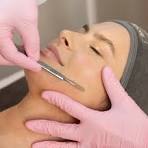
Dermaplane
Dermaplaning facial is a gentle exfoliation treatment that uses a sterile surgical scalpel to remove dead skin cells and fine vellus hair, often referred to as “peach fuzz.” This process reveals a smoother, brighter complexion and enhances the absorption of skincare products. Ideal for achieving a flawless makeup application, dermaplaning can also help reduce the appearance of fine lines and uneven texture. The treatment is quick and requires no downtime, making it a popular choice for anyone looking to refresh their skin and achieve a radiant glow.
Price: $100
FAQs:
What is dermaplaning, and how does it work?
Dermaplaning is a non-invasive exfoliation procedure that involves using a sterile, surgical scalpel to gently remove dead skin cells and fine vellus hair (peach fuzz) from the surface of the skin. This process promotes smoother skin, enhances the effectiveness of skincare products, and improves the appearance of makeup by creating a soft, even canvas.
Is dermaplaning safe for all skin types?
Yes, dermaplaning is generally safe for most skin types, including sensitive skin. However, it is not recommended for individuals with active acne, rosacea, eczema, or very oily skin, as the procedure may aggravate these conditions. A skincare professional will assess your skin type and condition to determine if dermaplaning is appropriate for you.
Will dermaplaning make my hair grow back thicker or darker?
No, dermaplaning does not change the thickness, color, or growth rate of your hair. The fine vellus hair removed during dermaplaning will grow back at the same rate and texture as before. The belief that shaving or dermaplaning causes hair to grow back thicker is a common myth.
How often should I get dermaplaning done?
Dermaplaning can be done every 4 to 6 weeks, depending on your skin’s needs and how quickly your hair and dead skin cells accumulate. Regular treatments can help maintain smooth, glowing skin, but your esthetician will recommend a schedule tailored to your skin type and goals.
Is there any downtime or aftercare required after dermaplaning?
Dermaplaning has little to no downtime, and most people can return to their normal activities immediately after the procedure. Some mild redness may occur, but it typically subsides within a few hours. It's important to protect your skin from the sun by applying sunscreen and avoiding direct sun exposure for a few days, as the newly exposed skin may be more sensitive. Hydrating and moisturizing the skin after treatment is also recommended.
